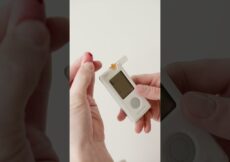Newborn or neonatal eye discharge occurs in babies born with an underdeveloped or blocked tear duct (or nasolacrimal duct). It does not indicate any serious medical condition. The block usually clears up within a few months after birth. However, there might be other causes for the discharge, such as a bacterial infection or an allergy that require medical attention.
Read on to know about the causes and treatment options for newborn eye discharge.
Is It Normal For Newborns To Have Eye Discharge?
In the initial days post-birth, it is normal for newborns to have eye discharge or sticky eyes. It could be due to a blocked tear duct when the eye’s drainage system is partially or completely blocked (1). Studies have estimated that nearly 20% of babies are born with a blocked tear duct. But the condition usually self resolves within four to six months. However, if a discharge is accompanied by signs of infection, such as redness or puffiness, it is advisable to see your baby’s pediatrician.
You may tell if the discharge is normal based on its color.
- White-colored discharge: White discharge is common and will usually disappear within a few months.
- Yellow-colored discharge: Yellow discharge might be because of a blocked tear duct or some infection. This sticky discharge makes it difficult for the babies to open their eyes properly.
- Green-colored discharge: Green-colored discharge indicates the signs of an eye infection.
What Are The Causes Of Newborn Eye Discharge?
The common cause of eye discharge in newborn babies is a blocked tear duct. However, it might not be the cause always. Newborn eye discharge may also occur due to other conditions.
- Nasolacrimal duct obstruction: A nasolacrimal duct obstruction or blocked tear duct occurs when the nasal passages cannot clear the liquid from the eyes (2). Blocked tear ducts are commonly seen in newborns and can go away without medical intervention.
- Viral conjunctivitis (pink eye): It is the inflammation of the membranes lining the inside of the eyelids covering the eyeballs (3). It is also known as pink eye because the eye appears pink or red upon infection. The condition is due to an infection, irritation, or a blocked tear duct. Sometimes, it can occur due to the passage of viral particles from the mother’s vagina to the baby during birth, known as chemical conjunctivitis (4).
- Bacterial conjunctivitis: Certain bacteria present in the mother’s vagina pass on to the baby during birth and cause bacterial conjunctivitis (5). The bacteria could be Chlamydia, Streptococcus pneumoniae, Haemophilus influenzae, Neisseria gonorrhoeae, among others. The symptoms of conjunctivitis caused by each of the bacteria differ from one another.
- Allergies: If your newborn is sensitive to environmental changes and factors, such as dust, pollen, or smoke, they might develop allergies due to seasonal changes,.W This might eventually lead to an allergic reaction in the eyes, causing allergic conjunctivitis.
- Sty: A sty is an infection that occurs at the base of the eyelashes and is caused by Staphylococcus aureus (6). It looks like a small red swollen pimple in the lower lid. There might be painful swelling around the eyes, but it does not cause any permanent damage to the eyes. When the sty pops, it leads to the discharge of yellow pus.
- Injury to the eyes: If the baby’s eyes are injured by any object or due to the accumulation of dirt, it can lead to watery discharge in the eyes and causes redness around the pupil.
How Is Newborn Eye Discharge Treated?
The treatment options for newborn eye discharge depend on its cause and severity. For example, mild eye discharge can be treated at home but only after proper consultation with a medical practitioner.
1. Home treatment
A blocked tear duct can be treated at home by a parent or a healthcare provider. First, wash your hands with soap and water before touching the baby’s eyes to reduce the risk of infections (4). The, wipe off the discharge with a soft piece of cloth dipped in warm water. In swollen eyelids and pain around the baby’s eyes, a warm compress can help relieve the pain (6).
Protect your baby’s eyes from exposure to dust, wind, cold weather, or strong sunlight to prevent further risks of eye discharge.
2. Medical treatment
Doctors usually recommend performing a nasolacrimal duct probing if the blocked tear duct does not open within a year after birth (7). A small probe is used to open the tear duct and clean the accumulated dirt in this procedure.
In case of discharges caused due to bacterial or viral infections or allergies, the doctor may prescribe mild antibiotic eye drops or erythromycin ointment for the treatment.
What Are The Complications Of Newborn Eye Discharge?
Blocked tear ducts can sometimes lead to infections (8) or result in complications, such as acute dacryocystitis. Dacryocystitis results in the stagnation of tears that will provide a favorable environment for the growth of bacteria and other pathogens. This might cause severe pain and inflammation in the areas around the eyes (9)
When To See A Doctor?
It is important to consult your baby’s pediatrician if you notice any of these signs of eye infection.
- Block in the tear duct that does not resolve even after six to eight months
- Puffy eyelids
- Redness around the pupil
- Green or yellow discharge
- Excessive rubbing of eyes
- Pus discharge
- Difficulty in opening eyes
It is better to opt for differential diagnosis in such cases.
Frequently Asked Questions
1. Can a cold cause eye discharge in newborns?
Watery discharge and redness in the eye are common signs of cold in infants. However, if the discharge is yellow, it might indicate an eye infection.
2. Does breast milk cause newborn eye discharge?
It is believed that breast milk contains antibacterial properties, which could aid in treating eye infections in infants upon application. However, it is not advisable as it might lead to further complications (10).
A blocked tear duct can lead to eye discharge in your newborn. But it eventually clears up by the time your baby is one-year-old. There might also be other bacterial or viral reasons, which can cause these discharges or neonatal conjunctivitis, requiring medical attention. Checking with your baby’s eye doctor if you have any questions or concerns can help treat the condition as early as possible.
References:
MomJunction’s articles are written after analyzing the research works of expert authors and institutions. Our references consist of resources established by authorities in their respective fields. You can learn more about the authenticity of the information we present in our editorial policy.
The following two tabs change content below.




































